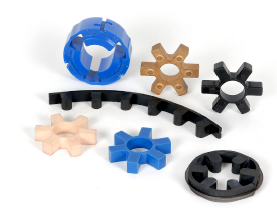Elastomers In Compression
We gives 4 varieties of elastomer types to permit for supplemental versatility in addressing unique application demands. One particular piece models are utilized in the “L” and “AL” models (known as spiders) and many aspect “load cushions” are utilized in the “C” and “H” model couplings. The load cushions are in sets of 6 to 14 pieces dependant upon coupling size.
Solid Center Spider
The solid center layout is normally utilized style when shafts of the driver and driven tools might be stored separate by  a common gap
a common gap
Open Center Spider
The open center layout permits to the shafts with the driver and driven to be positioned inside a brief distance
Open center spiders present shaft positioning versatility but possess a reduced RPM capacity
Cushions
Utilised exclusively for the C and H Form couplings
Load cushions are held in spot radially by a steel collar and that is connected to one of several hubs
Snap Wrap Versatile Spider
Design lets for uncomplicated removal in the spider without the need of moving the hubs
Allows for near shaft separation the many way up to the hubs greatest bore
Optimum RPM is one,750 RPM together with the retaining ring, but when applied with all the LC Style (with collar) the ordinary RPM rating from the coupling applies
Type is available in NBR and Urethane only, and in limited sizes
Spider Supplies
SOX (NBR) Rubber
The normal materials that is definitely extremely flexible material that may be oil resistant
Resembles normal rubber in resilience and elasticity, and operates effectively in temperature ranges of -40° to 212° F (-40° to 100° C)
Urethane
Has 1.five times higher torque capability than NBR
Excellent resistance to oil and chemicals
Materials presents significantly less dampening effect and operates at a temperature variety of -30° to 160° F
Hytrel
Versatile elastomer intended for higher torque and substantial temperature operations
Operates in temperatures of -60° to 250° F (-51° to 121° C)
Bronze
Rigid, porous, oil-impregnated metal insert solely for very low velocity (max 250 RPM) applications requiring high torque abilities
Not affected by water, oil, filth, or intense temperatures – operates in temperatures of -40° to 450° F (-40° to 232° C)
